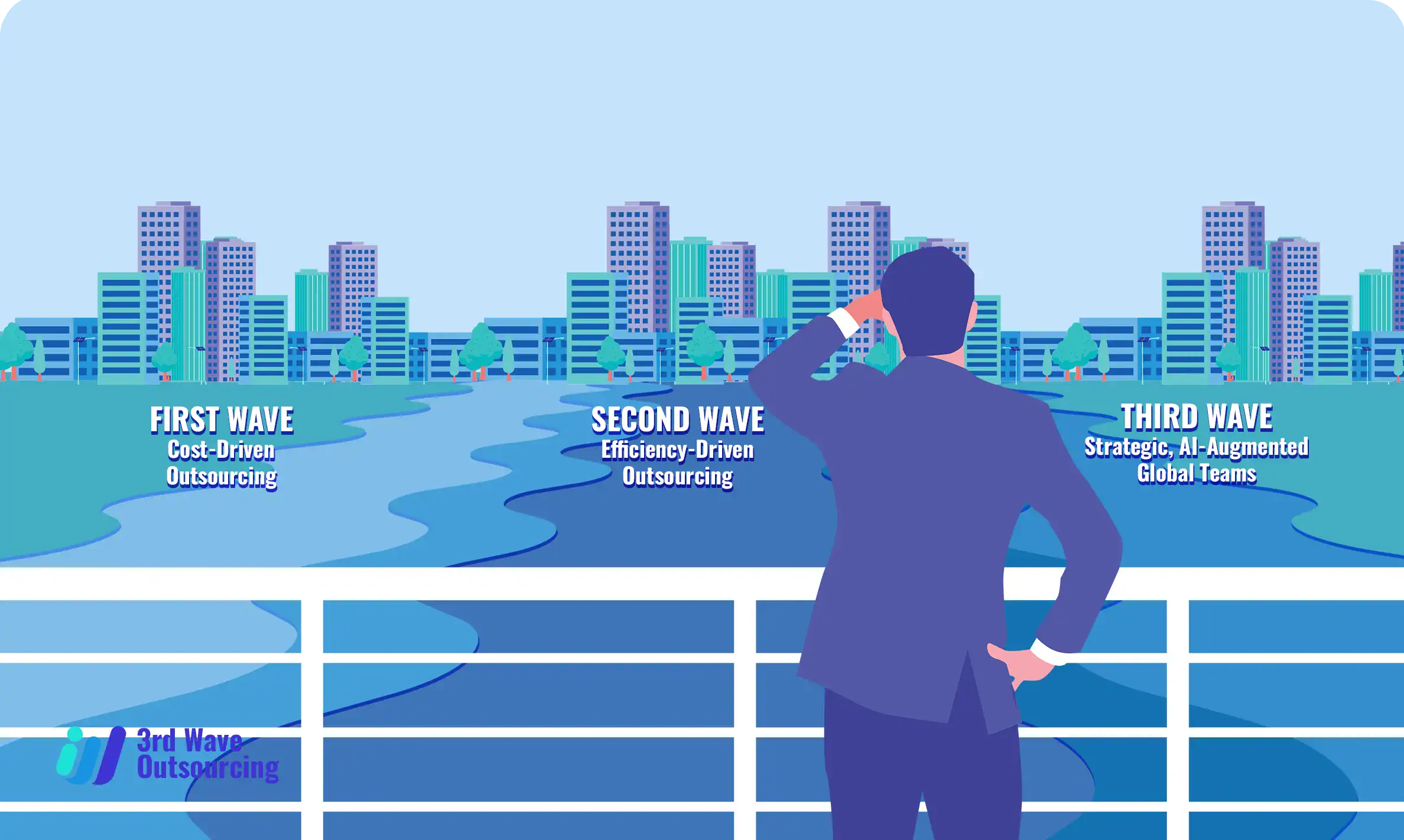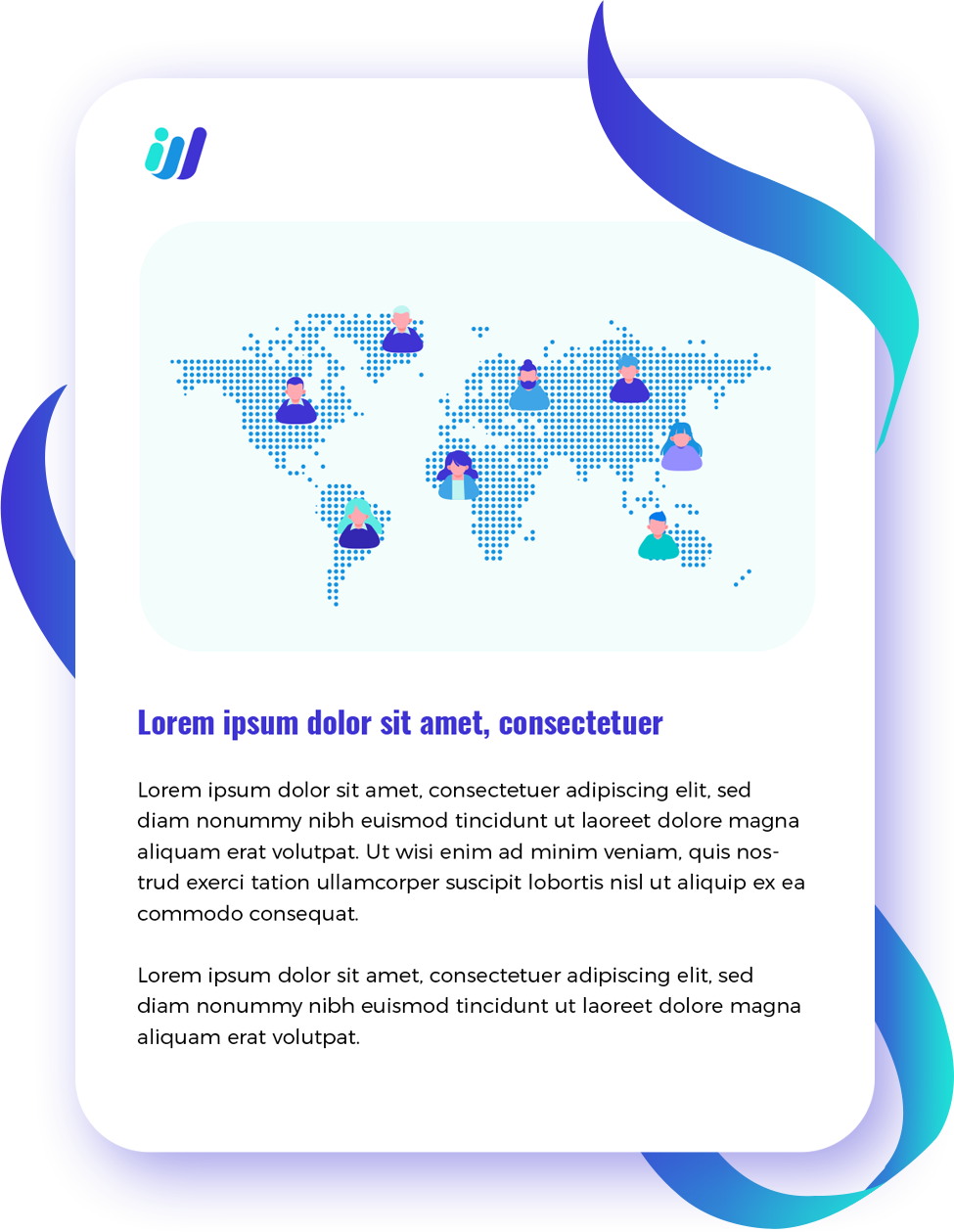For years, outsourcing was a dirty word in some boardrooms. It conjured up images of call centers, mass layoffs, and a race to the bottom on costs. But let’s be honest outsourcing, as we know it, is dead. In its place, a new model is rising. It’s more strategic, more dynamic, and it’s changing the way competitive businesses are built.
This shift is the Third Wave of Outsourcing (Harvard Business Review). If you’re a CEO, founder, or leader using old-school vendor models, it’s time to rethink.
From “Your Mess for Less” to High-Impact Partnerships
Traditional outsourcing (First and Second Waves) focused on cost-cutting via offshoring repetitive tasks. It created rigid contracts, cultural gaps, and quality issues. The Third Wave, however, prioritizes doing better and faster by leveraging global talent, intelligent automation, and true partnerships—not just contracts.
The Third Wave, however, isn’t just about getting things done cheaply. It’s about doing better, faster, and more intelligently by leveraging global talent, smart automation, and real partnerships—not just contracts. In fact, the smartest companies today aren’t just outsourcing—they’re co-creating.
What Is the Third Wave of Outsourcing?
The Third Wave is defined by three big shifts:
- Intelligent Automation – Think beyond robotic process automation. Today’s tools include generative AI, predictive analytics, and machine learning that drive decision-making, not just data processing.
- Borderless Talent Integration – With remote work normalized, companies can tap into global talent pools—not just for cost savings, but to find specialized expertise in real time.
- Strategic Partnerships – Instead of transactional vendor relationships, Third Wave outsourcing involves shared goals, co-investment, and aligned incentives.
In short: it’s not about cutting corners; it’s about gaining an edge.
Why CEOs Should Care Now
Here’s the reality: the way we build companies has changed.
We’re living in an environment defined by rapid change, digital acceleration, and increasing competition. In this kind of world, speed, flexibility, and access to innovation are more important than ever. Outsourcing—done right—can help you unlock all three.
For CEOs and executives, this isn’t a task to delegate to work on. It’s a leadership decision. Strategic outsourcing can help you:
- Launch new products faster
- Expand into new markets more easily
- Access cutting-edge technologies without huge upfront investment
- Re-focus your internal teams on core, value-driving work
It’s no longer just a back-office move. It’s a frontline business strategy.
Real-World Examples: Who’s Doing It Right?
This isn’t just a theory. Many of today’s most successful companies have used Third Wave outsourcing to scale fast and win big.
- Slack outsourced early product design and development to a Canadian firm called MetaLab. This helped them create a standout user experience from the start—without hiring a full in-house dev team.
- WhatsApp used offshore developers to build the app while their small team focused on growth and user engagement. This lean approach helped them scale to over a billion users before being acquired by Facebook.
- Airbnb built a global customer support network by partnering with skilled teams in the Philippines, enabling them to serve guests around the world while focusing internal efforts on growth and platform improvements.
None of these companies gave away their secret sauce. Instead, they partnered strategically to move faster, stay lean, and scale smart.
The Four Pillars of Third Wave Outsourcing
Let’s break down what makes this model work. These four pillars make up the backbone of any successful Third Wave outsourcing strategy.
1. Intelligent Automation as a Growth Engine
We’re way past just automating data entry. AI today can help you predict customer churn, personalize user experiences at scale, or flag financial anomalies in real time. You don’t need to build it all yourself—partners can help you access this tech without blowing up your budget.
2. True Strategic Partnerships
The old vendor/client model is gone. In its place: long-term partnerships based on shared outcomes, co-innovation, and sometimes even risk-sharing. You’re not just paying someone to do work—you’re aligning goals and building together.
3. Borderless Talent Access
One of the biggest benefits of this new wave? You’re no longer limited by geography. Whether it’s top-tier data scientists in India, UX designers in Eastern Europe, or project managers in LATAM, you can build a best-in-class team without relocating or overhiring.
4. Redefined ROI
This is a big one. The ROI of outsourcing used to be all about cutting costs. Now, it’s about speed, customer experience, innovation, and market impact. If you’re not measuring those things, you’re missing real value.
Common Myths (That Need to Die)
“It’s only for big companies.”
Wrong. Small and midsize businesses benefit the most—outsourcing lets you act like a big player without the overhead.
“You lose control.”
Actually, Third Wave partnerships give you more control. With outcome-based contracts and real-time dashboards, you can track performance and make agile changes.
“It’s all about cost savings.”
Cost savings are a benefit, sure—but they’re not the goal. The goal is to build faster, smarter, and better.
How to Get Started
Ready to explore what Third Wave outsourcing could look like for your business? Here’s a quick roadmap:
- Audit Your Value Chain
What are you great at—and what’s slowing you down? Look for functions that aren’t part of your core differentiator but could be transformed with the right partner.
- Find the Right Partner, Not the Cheapest Vendor
Look for alignment on values, communication style, and strategic fit. Ask about innovation, flexibility, and shared incentives—not just cost per hour.
- Start Small, Then Scale
Begin with one function or project, then build from there. The most successful partnerships evolve over time.
- Track the Right Metrics
Don’t just track how much you’re saving. Track what really matters: time-to-market, customer experience, innovation speed, and growth impact.
Final Thoughts: The Future Is Collaborative
The days of treating outsourcing as an operational afterthought are over. Today, it’s a strategic lever—and one that can unlock speed, scale, and innovation if used wisely.
The best leaders don’t do everything themselves. They build ecosystems of talent, tools, and partners that help them move faster and go further. The Third Wave of outsourcing isn’t about losing control—it’s about gaining capacity.
So ask yourself: what could your company do if you had access to the best talent, tools, and technologies in the world—without the friction of hiring, training, or scaling alone?
That’s the promise of the Third Wave. And it’s one that smart CEOs can’t afford to ignore.
Ready to dive deeper into how Third Wave Outsourcing can future proof your business strategy? Download our comprehensive ebook to explore the nuances of finding the best talent, building powerful partnerships, and leveraging this global shift for sustained success. The future of outsourcing is here. Are you prepared to embrace it?


